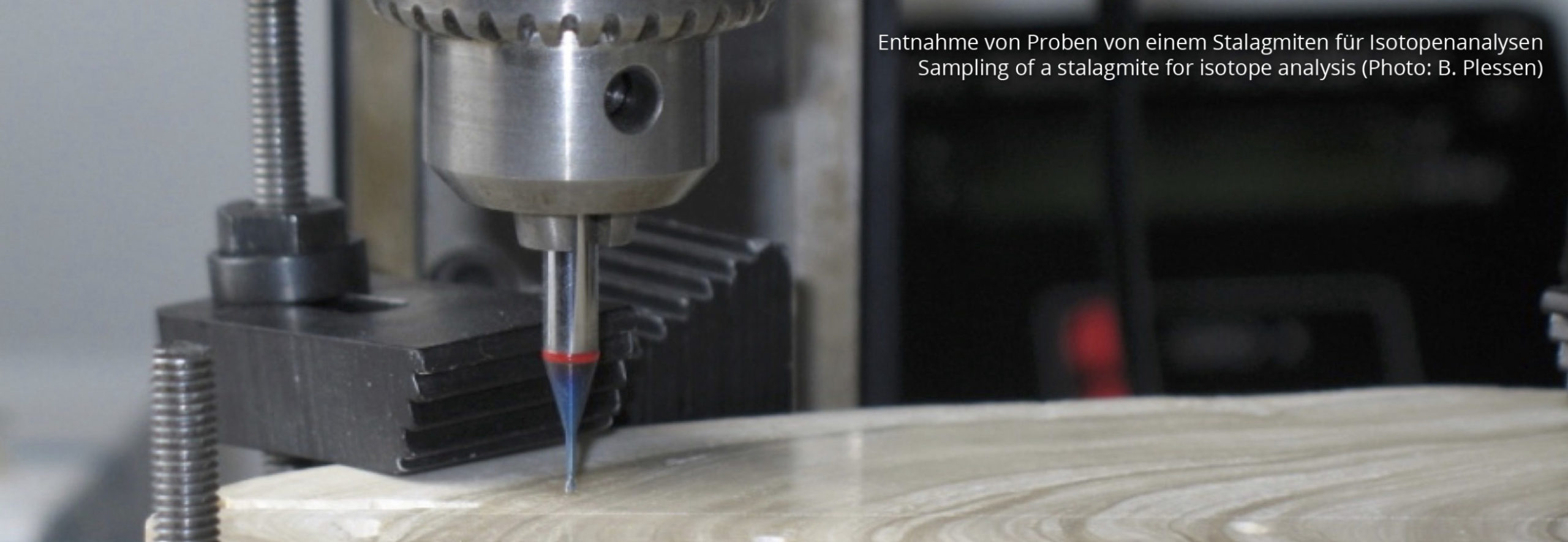Die Arbeitsgruppe Aquatische Geomikrobiologie besteht seit 2004 und wird von Prof. Dr. Kirsten Küsel geleitet. Die Gruppe befasst sich mit der Rolle von Mikroorganismen in den biogeochemischen Kreisläufen der Erde. Hier sind Mikroben auch an der Mineralausfällung und -auflösung sowie der Sorption von organischem Material beteiligt. Die Forschung umfasst die Bereiche BiodiversitätBiodiversität Vielfalt biologischen Lebens ("Artenreichtum")., mikrobielle Interaktionen, Klimaschutz, Bergbau und die tiefe BiosphäreBiosphäre Gesamtheit aller Räume der Erde, in denen Lebewesen vorkommen..
Zur Bleßberghöhle wurden im Rahmen des Forschungsprojektes „AquaDiv@Jena“ und des SFB 1076 „AquaDiva“ die Vielfalt und Aktivität der enthaltenen Bakterien und deren Bildung von Karbonatmineralen erforscht.
Ansprechpartner
Webseite
https://www.geomicrobiology.uni-jena.de/
Publikationen
Keiner, Robert; Frosch, Torsten; Hanf, Stefan; Rusznyak, Anna; Akob, Denise M; Küsel, Kirsten; Popp, Jürgen
In: Analytical Chemistry, Bd. 85, Nr. 18, S. 8708–8714, 2013.
@article{Keiner2013,
title = {Raman Spectroscopy—An Innovative and Versatile Tool To Follow the Respirational Activity and Carbonate Biomineralization of Important Cave Bacteria},
author = {Robert Keiner and Torsten Frosch and Stefan Hanf and Anna Rusznyak and Denise M Akob and Kirsten Küsel and Jürgen Popp},
doi = {10.1021/ac401699d},
year = {2013},
date = {2013-09-01},
urldate = {2013-09-01},
journal = {Analytical Chemistry},
volume = {85},
number = {18},
pages = {8708–8714},
abstract = {Raman gas spectrometry is introduced as a unique tool for the investigation of the respiratory activity that is indicative for growth of bacteria involved in biomineralization. Growth of these bacteria cannot be monitored using conventional turbidity-based optical density measurements due to concomitant mineral formation in the medium. The respiratory activity of carbonate-precipitating Arthrobacter sulfonivorans, isolated from the recently discovered Herrenberg Cave, was investigated during its lifecycle by means of innovative cavity-enhanced Raman gas analysis. This method allowed rapid and nonconsumptive online quantification of CO2 and O2 in situ in the headspace of the bacterial culture. Carbon dioxide production rates of A. sulfonivorans showed two maxima due to its pleomorphic growth lifecycle. In contrast, only one maximum was observed in control organism Pseudomonas fluorescens with a one-stage lifecycle. Further insight into the biomineralization process over time was provided by a combination of Raman macro- and microspectroscopy. With the help of this spatially resolved chemical imaging of the different types of calcium carbonate minerals, it was elucidated that the surface of the A. sulfonivorans bacterial cells served as nuclei for biomineralization of initially spherical vaterite precipitates. These vaterite biominerals continued growing as chemically stable rock-forming calcite crystals with rough edges. Thus, the utilization of innovative Raman multigas spectroscopy, combined with Raman mineral analysis, provided novel insights into microbial-mediated biomineralization and, therefore, provides a powerful methodology in the field of environmental sciences.},
keywords = {},
pubstate = {published},
tppubtype = {article}
}
Rusznyák, Anna; Akob, Denise M; Nietzsche, Sándor; Eusterhues, Karin; Totsche, Kai Uwe; Neu, Thomas R; Frosch, Torsten; Popp, Jürgen; Keiner, Robert; Geletneky, Jörn; Katzschmann, Lutz; Schulze, Ernst-Detlef; Küsel, Kirsten
In: Applied and Environmental Microbiology, Bd. 78, Nr. 4, S. 1157–1167, 2012.
@article{Rusznyak2012,
title = {Calcite Biomineralization by Bacterial Isolates from the Recently Discovered Pristine Karstic Herrenberg Cave},
author = {Anna Rusznyák and Denise M Akob and Sándor Nietzsche and Karin Eusterhues and Kai Uwe Totsche and Thomas R Neu and Torsten Frosch and Jürgen Popp and Robert Keiner and Jörn Geletneky and Lutz Katzschmann and Ernst-Detlef Schulze and Kirsten Küsel},
doi = {10.1128/AEM.06568-11},
year = {2012},
date = {2012-02-01},
urldate = {2012-02-01},
journal = {Applied and Environmental Microbiology},
volume = {78},
number = {4},
pages = {1157–1167},
abstract = {Karstic caves represent one of the most important subterranean carbon storages on Earth and provide windows into the subsurface. The recent discovery of the Herrenberg Cave, Germany, gave us the opportunity to investigate the diversity and potential role of bacteria in carbonate mineral formation. Calcite was the only mineral observed by Raman spectroscopy to precipitate as stalactites from seepage water. Bacterial cells were found on the surface and interior of stalactites by confocal laser scanning microscopy. Proteobacteria dominated the microbial communities inhabiting stalactites, representing more than 70% of total 16S rRNA gene clones. Proteobacteria formed 22 to 34% of the detected communities in fluvial sediments, and a large fraction of these bacteria were also metabolically active. A total of 9 isolates, belonging to the genera Arthrobacter , Flavobacterium , Pseudomonas , Rhodococcus , Serratia , and Stenotrophomonas , grew on alkaline carbonate-precipitating medium. Two cultures with the most intense precipitate formation, Arthrobacter sulfonivorans and Rhodococcus globerulus , grew as aggregates, produced extracellular polymeric substances (EPS), and formed mixtures of calcite, vaterite, and monohydrocalcite. R. globerulus formed idiomorphous crystals with rhombohedral morphology, whereas A. sulfonivorans formed xenomorphous globular crystals, evidence for taxon-specific crystal morphologies. The results of this study highlighted the importance of combining various techniques in order to understand the geomicrobiology of karstic caves, but further studies are needed to determine whether the mineralogical biosignatures found in nutrient-rich media can also be found in oligotrophic caves.},
keywords = {},
pubstate = {published},
tppubtype = {article}
}
